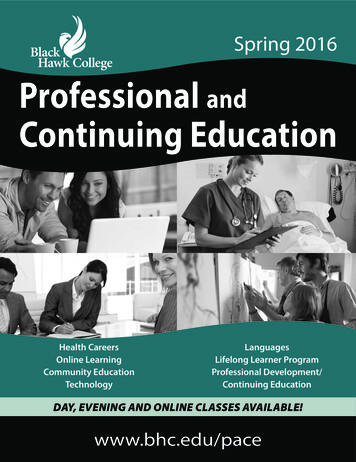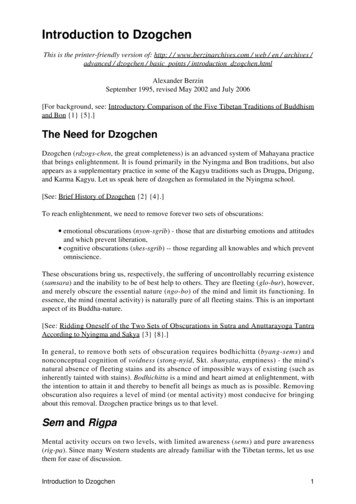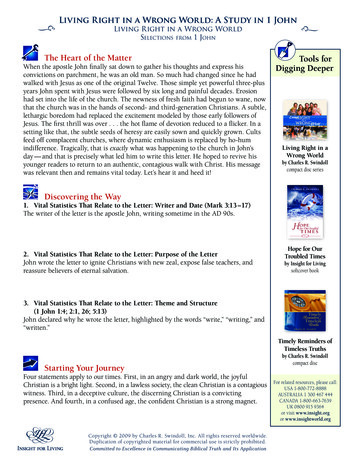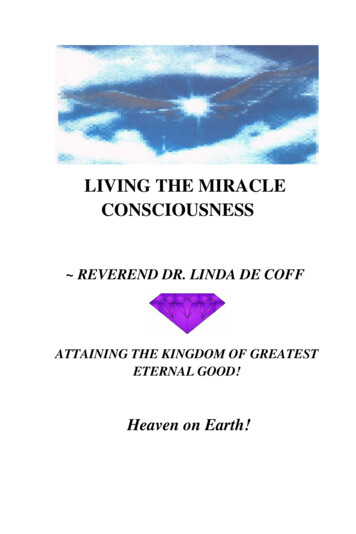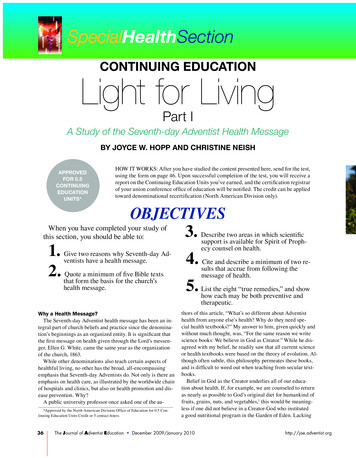
Transcription
SpecialHealthSectionCONTINUING EDUCATIONLight for LivingPart IA Study of the Seventh-day Adventist Health MessageBY JOYCE W. HOPP AND CHRISTINE NEISHAPPROVEDFOR 0.5CONTINUINGEDUCATIONUNITS*HOW IT WORKS After you have studied the content presented here, send for the test,using the form on page 46. Upon successful completion of the test, you will receive areport on the Continuing Education Units you’ve earned, and the certi¿cation registrarof your union conference of¿ce of education will be noti¿ed. The credit can be appliedtoward denominational recerti¿cation (North American Division only).OBJECTIVESWhen you have completed your study oftwo areas in which scienti¿c3. Describethis section, you should be able tosupport is available for Spirit of 3rophecy counsel on health.1. ventistsGive two reasons why Seventh-day Adhave a health message.4. sultsCite and describe a minimum of two rethat accrue from following the2. thatQuote a minimum of ¿ve Bible textsmessage of health.form the basis for the church’shealth message.5. Listthe eight ³true remedies, and showhow each may be both preventive andtherapeutic.Why a Health Message?The Seventh-day Adventist health message has been an integral part of church beliefs and practice since the denomination’s beginnings as an organized entity. It is signi¿cant thatthe ¿rst message on health given through the Lord’s messenger, Ellen G. White, came the same year as the organizationof the church, 1863.While other denominations also teach certain aspects ofhealthful living, no other has the broad, all-encompassingemphasis that Seventh-day Adventists do. Not only is there anemphasis on health care, as illustrated by the worldwide chainof hospitals and clinics, but also on health promotion and disease prevention. Why"A public university professor once asked one of the au*Approved by the North American Division Of¿ce of Education for 0.5 Continuing Education Units Credit or 5 contact hours.36thors of this article, ³What’s so different about Adventisthealth from anyone else’s health" Why do they need special health textbooks" My answer to him, given quickly andwithout much thought, was, ³For the same reason we writescience books We believe in God as Creator. While he disagreed with my belief, he readily saw that all current scienceor health textbooks were based on the theory of evolution. Although often subtle, this philosophy permeates these books,and is dif¿cult to weed out when teaching from secular textbooks.Belief in God as the Creator underlies all of our education about health. If, for example, we are counseled to returnas nearly as possible to God’s original diet for humankind offruits, grains, nuts, and vegetables,1 this would be meaningless if one did not believe in a Creator-God who instituteda good nutritional program in the Garden of Eden. LackingThe Journal of Adventist Education U December 2009/January 2010http://jae.adventist.org
such a foundation, we wouldbe left to drift with the whimof every nutritional fad. Although Adam and Eve bene¿ted from their access to thetree of life while they were inthe Garden of Eden, a privilege we will not share untilwe reach heaven, we can stillchoose the most healthful foods from what is available to usnow. A safe guide for health and diet can be found in both theBible and the writings of Ellen White.Our message of health and healing is also revealed and illustrated by God’s Son in Hisearthly ministry. Christ devoted more time to healingthan to preaching.2 We havea responsibility to share andmodel this message ³Theworld needs today what itneeded nineteen hundred yearsago—a revelation of Christ. 3The Seventh-day Adventisthealth message also helps usprepare for the second coming of Christ. Ellen White asserts that as we draw nearer tothe close of time, we shall have to rise higher and still higheron the subject of health reform.4 God gave special health instructions because of His love for us. Sometimes we may betempted to think of our health message as restrictive (³can’teat this, ³can’t drink that ), when in reality those very ³restrictions preserve our health, lengthen our lives, and enhance our ability to serve.If we follow God’s health message, we will develop clearerminds to understand His truth for this time and stronger bodies to carry out His will. The quality of our health affects every dimension of our lives mental, emotional, physical, andspiritual.Benefits to Ancient IsraelAfter bringing them out of Egypt, God promised the Israelites ³If you listen carefully to the voice of the Lord your Godand do what is right in his eyes, if you pay attention to hiscommands and keep all his decrees, I will not bring on youany of the diseases I brought on the Egyptians, for I am theLord, who heals you (Exodus 15 26, NIV).5What were the diseases of Egypt from which God’s healthmessage was to save the Israelites" The Bible records some ofthe health problems of those people Leprosy (this genericterm includes a number of skin disorders such as psoriasis and vitiligo, as well as true leprosy),6 and sexually transhttp://jae.adventist.orgmitted diseases.7 Evidence ofmany ancient diseases havebeen discovered through thescience of paleopathology, thestudy of disease in ancient fossils. 3aleopathologists haveautopsied 36,000 mummies.8From these autopsies andmore recently, X-rays of mummies,9 they have discovered that ancient Egyptians sufferedthe same diseases as people today heart disease and arteriosclerosis, cancer, polio, tuberculosis, cirrhosis of the liver,gallstones, kidney stones, smallpox, malaria, tetanus, gout,arthritis, osteoporosis, pneumonia, diabetes, dysentery, ironde¿ciency anemia, dental decay, and goiter. Some of the ruling class were extremely obese, as revealed by the mummiesof kings Thutmoses II, Ramses III, and Amenhotep III.The counsel given through Moses to the children of Israelwould have prevented many of these diseases. Although manypeople consider illness to be merely fate or bad luck, Davidreminds us, ³Some were sick through their sinful ways, andbecause of their iniquities endured afÀiction (3salm 107 17,NRSV).10The bene¿t of God’s health counsel was not to be limitedto the Israelites ³That thy way may be known upon earth,thy saving health among all nations (3salm 67 2, KJV). Allthat was required was obedience. ³My child, be attentive tomy words; incline your ear to my sayings. Do not let them escape from your sight; keep them within your heart. For theyare life to those who ¿nd them, and healing to all their Àesh (3roverbs 4 20-22, NRSV).Prohibition Against Consuming BloodAn important aspect of God’s dietary plan for the Israelites was the prohibition against consuming animal fat andblood. ³It shall be a perpetual statute throughout your generations, in all your settlements, that you must not eat anyfat or any blood (Leviticus 3 17, NRSV). The prohibition,of course, had religious connotations; blood represented thelife of God’s own Son, offered as a sacri¿ce for the sins ofthe human race. But mere symbolism and ceremony alone donot explain this strong restriction against the use of blood forfood.Modern science indicates that both human and animalblood contain waste products urea, amino acids, creatine,creatinine, uric acid, carbohydrates, organic acids, citric acid,ketoglutaric acid, malic acid, succinic acid, acetoacetic acid,lactic acid, pyruvic acids, lipids, plus all the hormones secreted by the endocrine glands. Many of the substances foundin blood are also found in urine, since both carry waste products destined for excretion from the body.The Journal of Adventist Education U December 2009/January 201037
SpecialHealthSectionThe law against eating animal fat makes good medicalsense. Atherosclerosis, heart disease, and stroke were rampant around the ³Àesh pots of Egypt, and God was trying tospare His people these maladies. ³Speak to the people of Israel saying, µ ou shall eat no fat of ox or sheep or goat. Thefat of an animal that died or was torn by wild animals may beput to any use, but you must not eat it’ (Leviticus 7 23, 24,NRSV). Dr. Gary Fraser, an epidemiologist at Loma LindaUniversity in California, points out that it is clear that thenutrients found in animal products do not produce protection against coronary heart disease as well as those found infruits, nuts, and vegetables. Meats generally contain a muchhigher percentage of saturated fats and cholesterol, no dietary¿ber, and relatively small quantities of antioxidant vitamins.11Tattooing and SanitationAs a precaution against infection, tattooing was forbiddento the Hebrews. ³µ ou shall not make any gashes in your Àeshfor the dead or tattoo any marks upon you’ (Leviticus 19 28,NRSV). The ancient Librans and earliest Egyptians practicedtattooing,12 which can transmit hepatitis, tetanus, AIDS, andother infectious diseases. Even though this counsel may havebeen given for religious reasons, italso had health bene¿ts.Environmental health measures,such as safe water and sanitarywaste disposal, are among the ¿rstmeasures to be instituted in developing countries to reduce death anddisease rates. The health message ofthe Israelites about the disposal ofhuman waste, if followed today inall parts of the world, would immediately improve health conditions asmuch as it did at that time. ³Designate a place outside the camp whereyou can go to relieve yourself. Aspart of your equipment have something to dig with, and whenyou relieve yourself, dig a hole and cover up your excrement (Deuteronomy 23 12, 13, NIV).When the Israelites followed the health instruction givenby the Creator, they indeed enjoyed better health and longerlife.Benefits TodayWhat is God’s message of health for today" What has itdone—and can it do—for Seventh-day Adventists who follow it"³3ure air, sunlight, abstemiousness, rest, exercise, properdiet, the use of water, trust in divine power—these are thetrue remedies. 13 When Ellen White wrote these words, she38was reminding us of God’s original gifts and counsel found inthe Bible1. Fresh air (Genesis 2 7);2. Sunlight (1 16);3. 3ure water (2 10);4. Exercise (2 15);5. 3roper diet (1 29);6. 3eriodic rest (1 5; 2 2);7. Abstemiousness (2 16, 17; 1 Corinthians 10 31); and8. Trust in and thankfulness to our Creator (Genesis 3 8;3salm 9 1, 2; 3roverbs 3 5, 6).Fresh AirOn the second day of Creation, God formed the Earth’s atmosphere. Then, on the sixth day, He created Adam. Godbreathed ³life-giving breath into his nostrils and the man began to live (Genesis 2 7, TEV).14Air is vital to living creatures. Each human cell takes inoxygen, uses it to burn food for energy, and excretes carbondioxide as waste. Without suf¿cient oxygen in the blood,muscles cannot contract, brain cells die, and the heart stopspumping. Respiration and blood circulation are the two vitalactivities of life. When these cease,life ends. Modern medicine has invented life-support machines thatreplicate the function of breathing,and keep the heart pumping forawhile, but they cannot restore life.The lungs are the living bellowsthat aerate the blood. Air entersthrough the trachea, which dividesinto bronchi, one going to the rightlung, the other to the left. Withinthe lungs, each bronchus progressively divides, like the roots of atree, into smaller and smaller passages until they become a mass ofsmall tubules barely visible to the naked eye. These ¿ne divisions end in grapelike clusters of air sacs (alveoli) numbering about 300 million. By far, the greatest part of the lungsis made up of these tiny air chambers, which are so light thatthey Àoat on water. The alveoli, though only 250 m in diameter, cover a vast area, between 50 to 100 m2 of surface areaavailable for gas exchange by diffusion.15Respiration consists of breathing air in and out. While atrest, an adult breathes some 16 times a minute (children 20times a minute) and takes in about a pint of air in each breath.This amounts to 8 quarts a minute or 480 quarts an hour. Humans breathe about 30 pounds of air every 24 hours.The Earth’s atmosphere is a vast body of gases, vapors, andparticles of suspended matter approximately 14 miles thick.The Journal of Adventist Education U December 2009/January 2010http://jae.adventist.org
About one-third of this is below 10,000 feet, and 75 percent ofit is below 29,000 feet.Air consists of about 78 percent nitrogen, 21 percent oxygen, 0.93 percent argon, and traces of carbon dioxide, helium,and other rare gases. Water, in the form of vapor, is presentin differing amounts, depending on location, time, and season. Humans and animals breathe in oxygen and give off carbon dioxide.Tens of millions of fossil-fuel-powered vehicles, and thousands of power plants and industries emit billions of tonsof pollutants into the air each year. This, along with pollution from other sources, is dispersed into the ocean of airsurrounding our planet by a mixing process created by alterations in temperature, wind velocity, terrain, and humidity. These gases react together under the inÀuence of heat,weather conditions, and ultraviolet radiation to produce smog.Research shows that periods of severe pollution result in increased respiratory infections and deaths in the exposed population.16Indoors, the most common pollutant is cigarette smoke,which damages the lungs of nonsmokers as well as smokers.³Tobacco is a slow, insidious, but most malignant poison, 17 Mrs.White wrote in 1905,long before the scienti¿c evidence had accumulated regarding therelationship betweencigarette smoking anddiseases such as lungcancer, heart disease,and emphysema. Children reared in homeswhere one or both parents smoke have morerespiratory infections.18 Sidestream smoke can be more dangerous to the health of non-smokers than the smoke inhaledby the smoker. Legislative action in different countries, aswell as most states in the United States and provinces in Canada, has prohibited smoking in buildings open to the public.Enforcement of such legislation, however, remains a problem,but one that can be addressed through community advocacy.Clean air, adequately circulated, is important in the classroom. Schoolrooms should have a means of purifying, ¿ltering, and circulating the air. Air conditioning is not necessary in many areas, although dehumidi¿cation may be. Ifclassrooms do not have forced-air ventilation, then windowsshould be able to be opened both from the top and the bottomto provide for air circulation. A bafÀe should be installed toprevent the air from blowing directly on students.http://jae.adventist.org3osture and exercise are also important to good breathing³Among the ¿rst things to be aimed at should be a correct position, both in sitting and in standing . . . .The one who sitsand stands erect is more likely than others to breathe properly. . .Show how the healthy action of the respiratory organs,assisting the circulation of the blood, invigorates the wholesystem, excites the appetite, promotes digestion, and inducessound, sweet sleep, thus not only refreshing the body, butsoothing and tranquilizing the mind. 19When people are sedentary, and in addition, sit, stand, andbreathe incorrectly, the apexes or tips of the lungs do not getthoroughly aired.Sunlight3eople get their energy from plants, but that energy was¿rst captured from the sun. Sunlight has many bene¿ts. Forexample, solar water disinfection (SODIS) is a simple, lowcost technology designed to improve the microbiologicalquality of drinking water through solar radiation and thermal treatment.20 Contaminated water is poured into transparent polyethylene terephthalate (3ET) bottles and exposed tofull sunlight for six hours (or for two consecutive days if thesky is more than 50 percent cloudy). Sunlight deactivates anddestroys pathogenic micro-organisms that cause waterbornediseases. This occurs through two synergetic mechanisms,namely, radiation in the UV-A spectrum and increased watertemperature.Sunlight is essential for good health and aids in recoveryfrom disease. The human body synthesizes Vitamin D, an essential nutrient, from exposure to sunlight. It can be overdone, however, especially in light-skinned people. 3rotection from excessive exposure to the sun’s rays can preventfuture problems with skin cancer. In Australia, a countryof sun-and-beach lovers, they have coined a slogan to remind citizens to protect against excess sun exposure SLI3,SLA3, SLO3, or ³Slip on a Shirt, Slap on a Hat, Slop on Sunscreen. 21Pure Water³From Eden a river Àowed out to water the garden (Genesis 2 10, CEV). Springs, rivers, and lakes provide humanswith fresh water to drink and also water for cleansing theirbodies. Dr. Mervyn Hardinge, in his syllabus on Philosophyof Health,22 provides the following information about water³The body of an average-sized man contains some 40 liters (42.5 quarts) of water, nearly 60 of his body weight. Ofthis, 25 liters are present inside the cells while 15 liters ¿ll thespaces between the cells. We think of bones as being dry, buteven marrow-free bone is 20 to 25% water. More physiologically active cells and tissues contain more water. Thus whilethe body as a whole may be from 50% to 70% water depend-The Journal of Adventist Education U December 2009/January 201039
SpecialHealthSectioning on the amount of fat it contains, thegray matter of the brain is 85% water.³Every function of life is carried outin a water medium. ou could not evenblink your eyelids if your tear glandsdid not constantly moisten the front ofyour eyeballs. Without this ¿lm of water the surface of your eyes would become dry and inÀamed and you couldnot open and shut them without greatpain . . . .³The 70 square meter surface area ofliving lung tissue is always moist. Eachyear an adult human breathes in and outfrom two to ¿ve million liters (quarts)of air. The oxygen of this air is carriedto the 300 million microscopic air sacscomprising the lungs. But it could not get through membranewalls of the air sacs and into the blood if it were not ¿rst dissolved in a ¿lm of Àuid that lessens surface tension. Withoutthis moisture oxygen could not get into your blood and carbondioxide could not get out; consequently, you would suffocate.³ our digestive system needs water to make its digestivejuices. The saliva that pours into your mouth every day measures a quart or more. This keeps your mouth and throatmoist, wets the food you eat so you can swallow it, and aidsin its digestion. our stomach, intestines, livers, and pancreassecrete about two gallons of juices a day to further digest andassimilate your food.³ our skin, too, requires water and a lot of it. Its 2.5 million sweat glands moisten it continually with a ¿ne perspiration of which you are not even aware. This keeps it from drying out and cracking . . . . It amounts to about a pint a day.Frequently, of course, you sweat much more profusely.³About half of the body water is found in the muscleswhich make up about one-third of the body mass. No wonderone feels fatigued when the muscles are short of water. Deathoccurs when about 20% of the body water has been lost.³Water is indispensible for cooling the body. Even at rest. . . a man’s body produces about 80 calories of heat per hour.That is almost enough heat to bring a quart of ice water toboil. ou need this heat to warm you in cool weather; butwhen the air is hot, you need water to cool you. During extreme heat or prolonged hard exercise, your skin may pourout several quarts of sweat per hour. . . . [Under normal conditions, your body uses about two-and-one-half quarts of water per day, but since many foods contain water, you needonly about six to eight cups per day.]³Experience and experiments have shown that man cannot maintain himself in health and ef¿ciency while reducing40his water intake. In a 1942 expeditionto the desert the endurance of men wastested.23 Men working in the heat werefound to be especially susceptible to exhaustion. But when they drank suf¿cient water it proved to be both an effective preventive and a cure. Two groupsof infantry men (20 in each group) weretaken on a march in the heat of the day.Trucks of water followed them. Themen in one group were allowed all thewater they wanted while the others received none. Seven of the 20 non-drinkers became exhausted and had to dropout, but only one of the water drinkerswas unable to complete the march.³It is easy enough to see why a person needs plenty of water to drink inhot weather especially while he is exercising and perspiring freely. But that high altitude climbers, struggling throughsnow and over ¿elds of ice also need an abundance of waterwas not recognized until it was demonstrated in the ¿rst successful assault of Mount Everest by Hillary in 1953.24³At high altitudes the amount of moisture in the atmosphere is low while the exhaled air is almost saturated withmoisture. Thus the climber, or the resident of high mountains,loses large amounts of water through his breath whetherhe sweats or not. The recognition of this fact by the scientists of Hillary’s expedition caused them to design specialhigh-altitude stoves that would melt snow and ice so that eachman had 5 to 7 pints of liquid a day. The Swiss party, who almost made the top the year before, had less than a pint of water per man per day for the last three days. It is thought thatlack of suf¿cient water—dehydration—might have contributed greatly to the extreme fatigue and weakness that made itimpossible for the men to continue even with the great urgeto succeed when they were within a thousand feet altitude oftheir goal.³Such voluntary dehydration is not practiced by any otheranimal that has been studied.25 When a dog or donkey mustgo without water for a time it will, at the ¿rst opportunity,drink enough to restore its water balance in a few minutesby drinking as much as it lost. A man drinks only about twothirds as much as he loses during an active period of exposure.26 Unless this is replaced by forced drinking, the temperature of the body will gradually rise to 102o F. and one entersthe zone of impending exhaustion. . . . ou cannot depend onyour sensations of thirst to get you to drink enough. 27A safe supply of water is essential to remaining healthy.Water-borne diseases, such as cholera and typhoid, are resurging in various countries. It takes continual effort byThe Journal of Adventist Education U December 2009/January 2010http://jae.adventist.org
public-health authorities to monitor and maintain safe water supplies. The Adventist Development and Relief Agency(ADRA) has been active in many parts of the world in providing wells and other safe supplies of water for villagers.Most people are aware of the need for washing the outsideof their bodies frequently, but many fail to pour enough water inside themselves to also cleanse their insides. It shouldbe just as automatic as washing your face in the morning todrink a glass or two of water to ³wash your insides, then follow with ¿ve or six more glasses during the day.Hand washing is one of the best means of preventing thespread of germs from one individual to another. Every classroom should have facilities for hand washing, and teachersshould insist that children use them often during the day.Classrooms are perfect environments for spreading germs,and as most teachers know by experience, the teacher is a frequent victim. Hand washing is the ¿rst and most importantpreventive measure. Classroom surfaces (doorknobs, computer keyboards and mice, desks, etc.) should regularly becleaned and sanitized with an antibacterial agent.heart, and blood vessels to take in oxygen, transport it to themuscle cells, process it, and carry off the waste products.Aerobic exercise uses the large muscle groups (the lower extremities contain the largest muscle groups in the body), isrhythmic, continuous (not the stop-and-start type), and intense enough to get the heart rate up to a target. Jogging, running, cycling, swimming, cross-country skiing, and briskwalking—all are aerobic activities. To be effective for weightcontrol, at least 20 minutes of strenuous activity is neededtwice a day. (Watching children play during recess or physical education period does not count as vigorous activity forthe teacher!)³There is no drug in current or prospective use that holdsas much promise for sustained health as a lifetime program ofphysical ¿tness. 31 3hysical education should be a regular partof each child’s school program from kindergarten throughhigh school. Athletic programs do not suf¿ce, since often thechildren who need activity the most are the ones who fail toparticipate in it. The statement ³the good get better and thepoor drop out is too often true of athletic programs.ExerciseThe way many people avoid exercise, you would think thehuman body was very frail. Just the opposite is true; it wasdesigned for vigorous activity. ³The Lord God took the manand put him in the garden of Eden to till it and keep it (Genesis 2 15, NRSV). ³Action is a law of our being.Every organ of the body has its appointed work,upon the performance of which its developmentand strength depends . . . . Inactivity is a fruitfulcause of disease. Exercise quickens and equalizes the circulation of the blood. 28At rest, the heart circulates about ¿ve liters ofblood per minute in both the athletically trainedand the untrained person. The average humanheart beats about 70 times per minute, pumping about two to three ounces with each beat.29However, when a highly trained person’s heartbeats 50 times per minute, it moves 100 ml ofblood with each beat. This is called the ³strokevolume. During exercise, the blood increases inproportion to the intensity of the activity. Sedentary males increase this volume from about 5 liters per minute at resting to 20-22 liters duringstrenuous exercise. World-class athletes can circulate 35-40 liters of blood per minute.Proper DietIn a 20-year study reported in Preventive Medicine, Drs.Belloc and Breslow identi¿ed health habits that led to longerlife. They came up with the following list1. No smoking;Types of Exercise³Walking is preferable to riding or driving forit brings more of the muscles into exercise. 30Aerobic ¿tness enhances the ability of the lungs,http://jae.adventist.orgThe Journal of Adventist Education U December 2009/January 201041
SpecialHealthSection2. Moderate use or abstinence from alcohol;3. Regular physical exercise;4. Seven to eight hours’ sleep per night;5. Maintenance of proper weight;6. Eating breakfast regularly; and7. No eating between meals.Each of these factors individually affected length of life;when combined, their effect increased in direct proportionto the number of good health habits practiced by each individual.32 Note that three of the seven habits fall in the area ofproper diet, although maintenance of proper weight includesphysical activity as well. ³The misuse of our physical powersshortens the period of time in which our lives can be used forthe glory of God. And it un¿ts us to accomplish the work Godhas given us to do. 33The principles that shouldguide us in diet and proper nutrition are outlined in The Ministry of Healing, in the chapterentitled, ³Diet and Health. Additional detailed information canbe found in Counsels on Dietand Foods.³In order to know what are thebest foods, we must study God’soriginal plan for man’s diet . . . .Grains, fruits, nuts and vegetables constitute the diet chosen for us by our Creator. Thesefoods, prepared in as simple and natural a manner as possible,are the most healthful and nourishing. 34³God has given us an ample variety of healthful foods, andeach person should choose from it the things that experienceand sound judgment prove to be best suited to his own necessities. 35³If we plan wisely, that which is most conducive to healthcan be secured in almost every land . . . rice, wheat, corn, andoats . . . also beans, peas, and lentils . . native or importedfruits, and the variety of vegetables that grow in each locality. 36³Far too much sugar is ordinarily used in foods. 37³Grains and fruits prepared free from grease, and in as natural condition as possible, should be the food for the tables ofall who claim to be preparing for translation to heaven. 38³Do not eat largely of salt, avoid the use of pickles andspiced foods . . . I use some salt, and always have, becausefrom the light given me by God, this article, in the place ofbeing deleterious, is actually essential for the blood. Thewhys and wherefores of this I do not know, but I give you theinstruction as it is given me. 39It is interesting to compare these principles with those pub-42lished by the United States departments of Agriculture, andHealth and Human Services in 1980 Eat a variety of foods. Maintain ideal weight. Avoid too much fat, saturated fat, and cholesterol. Eat foods with adequate starch and ¿ber. Avoid too much sugar. Avoid too much sodium. If you drink alcohol, do so in moderation.40The government pamphlet goes on to point out that people need 40 different nutrients to stay healthy. No single fooditem supplies all the essential nutrients (not even milk, contrary to advertising!). Milk contains very little iron or Vitamin C. Human beings therefore need to eat a variety offoods every day to ensure an adequate diet fruits, vegetables; whole-grain and enrichedbreads, cereals, and grain products; dried peas, beans, or nuts.In order to meet these guidelines, most people should Increase their intake of fruitsand vegetables by 10 percent; Increase their intake ofwhole grains by 30 percent; Decrease their intake of re¿ned and processed sugars by 50percent; Decrease their consumptionof fats and foods high in fat, especially animal fats, by 20 percent; Use low-fat milk and other low-fat dairy products; Decrease egg consumption by 25 percent; Decrease use of butter and high-cholesterol foods; Use less salt and fewer foods high in sodium, e.g. cannedsoups and chips; Tak
ger, Ellen G. White, came the same year as the organization of the church, 1863. While other denominations also teach certain aspects of healthful living, no other has the broad, all-encompassing emphasis that Seventh-day Adventists do. Not only is there an empha




